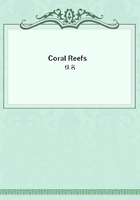
第96章
Westward of longitude 77 deg 30', on the northern side of Cuba, a great bank commences, which extends along the coast for nearly four degrees of longitude. In the place of its commencement, in its structure, and in the "CAYS," or low islands on its edge, there is a marked correspondence (as observed by Humboldt, "Pers. Narr." volume vii., page 88) between it and the Great Bahama and Sal Banks, which lie directly in front. Hence one is led to attribute the same origin to both these sets of banks; namely, the accumulation of sediment, conjoined with an elevatory movement, and the growth of coral on their outward edges; those parts which appear fringed by living reefs are coloured red. Westward of these banks, there is a portion of coast apparently without reefs, except in the harbours, the shores of which seem in the published plans to be fringed. The COLORADO SHOALS (see Captain Owen's charts), and the low land at the western end of Cuba, correspond as closely in relative position and structure to the banks at the extreme point of Florida, as the banks above described on the north side of Cuba, do to the Bahamas, the depth within the islets and reefs on the outer edge of the COLORADOS, is generally between two and three fathoms, increasing to twelve fathoms in the southern part, where the bank becomes nearly open, without islets or coral-reefs; the portions which are fringed are coloured red. The southern shore of Cuba is deeply concave, and the included space is filled up with mud and sandbanks, low islands and coral-reefs. Between the mountainous ISLE OF PINES and the southern shore of Cuba, the general depth is only between two and three fathoms; and in this part small islands, formed of fragmentary rock and broken madrepores (Humboldt, "Pers. Narr." volume vii. pages 51, 86 to 90, 291, 309, 320), rise abruptly, and just reach the surface of the sea. From some expressions used in the "Columbian Navigator" (volume i., part ii., page 94), it appears that considerable spaces along the outer coast of Southern Cuba are bounded by cliffs of coral-rock, formed probably by the upheaval of coral-reefs and sandbanks. The charts represent the southern part of the Isle of Pines as fringed by reefs, which the "Columb. Navig." says extend some way from the coast, but have only from nine to twelve feet water on them; these are coloured red.--I have not been able to procure any detailed description of the large groups of banks and "cays" further eastward on the southern side of Cuba; within them there is a large expanse, with a muddy bottom, from eight to twelve fathoms deep; although some parts of this line of coast are represented in the general charts of the West Indies, as fringed, I have not thought it prudent to colour them.
The remaining portion of the south coast of Cuba appears to be without coral-reefs.
YUCUTAN.
The N.E. part of the promontory appears in Captain Owen's charts to be fringed; coloured red. The eastern coast, from 20 deg to 18 deg is fringed. South of latitude 18 deg, there commences the most remarkable reef in the West Indies: it is about one hundred and thirty miles in length, ranging in a N. and S. line, at an average distance of fifteen miles from the coast. The islets on it are all low, as I have been informed by Captain B. Allen; the water deepens suddenly on the outside of the reef, but not more abruptly than off many of the sedimentary banks: within its southern extremity (off HONDURAS) the depth is twenty-five fathoms; but in the more northern parts, the depth soon increases to ten fathoms, and within the northernmost part, for a space of twenty miles, the depth is only from one to two fathoms. In most of these respects we have the characteristics of a barrier-reef; nevertheless, from observing, first, that the channel within the reef is a continuation of a great irregular bay, which penetrates the mainland to the depth of fifty miles; and secondly, that considerable spaces of this barrier-like reef are described in the charts (for instance, in latitude 16 deg 45' and 16 deg 12') as formed of pure sand; and thirdly, from knowing that sediment is accumulating in many parts of the West Indies in banks parallel to the shore; I have not ventured to colour this reef as a barrier, without further evidence that it has really been formed by the growth of corals, and that it is not merely in parts a spit of sand, and in other parts a worn down promontory, partially coated and fringed by reefs; I lean, however, to the probability of its being a barrier-reef, produced by subsidence. To add to my doubts, immediately on the outside of this barrier-like reef, TURNEFFE, LIGHTHOUSE, and GLOVER reefs are situated, and these reefs have so completely the form of atolls, that if they had occurred in the Pacific, I should not have hesitated about colouring them blue. TURNEFFE REEF seems almost entirely filled up with low mud islets; and the depth within the other two reefs is only from one to three fathoms.
From this circumstance and from their similarity in form, structure, and relative position, both to the bank called NORTHERN TRIANGLES, on which there is an islet between seventy and eighty feet, and to COZUMEL Island, the level surface of which is likewise between seventy and eighty feet in height, I consider it more probable that the three foregoing banks are the worn down bases of upheaved shoals, fringed with corals, than that they are true atolls, wholly produced by the growth of coral during subsidence; left uncoloured.